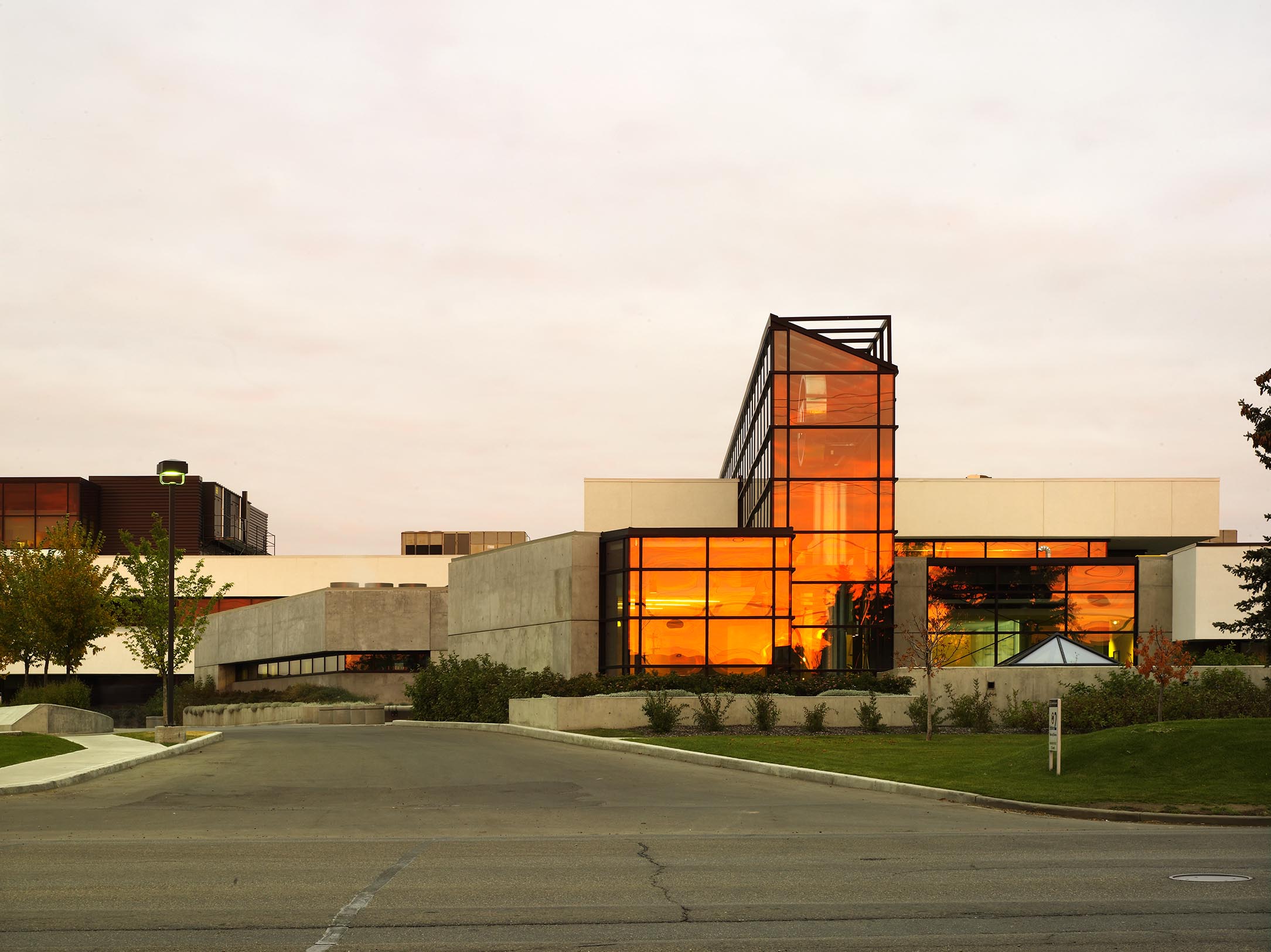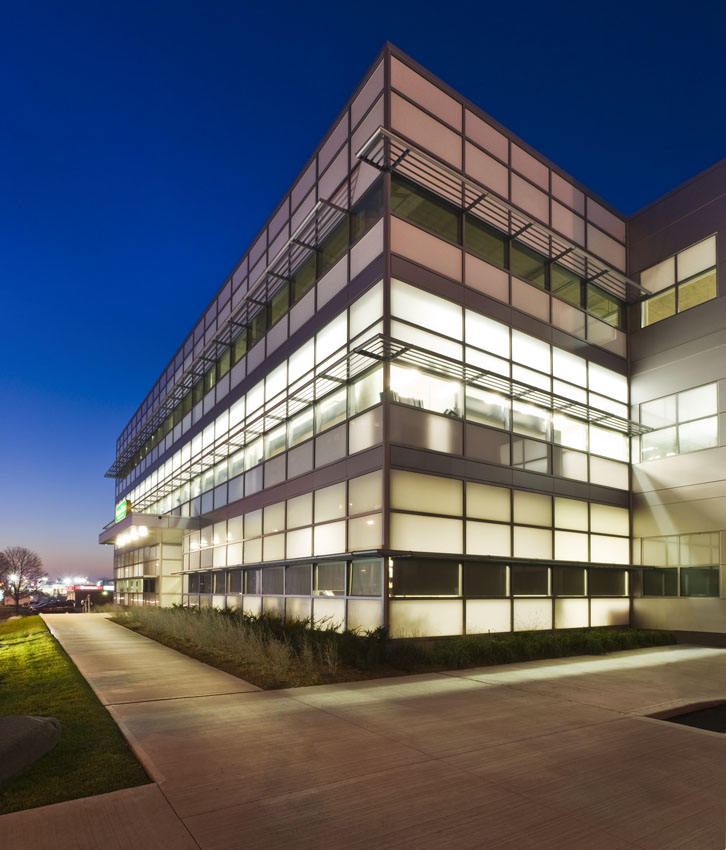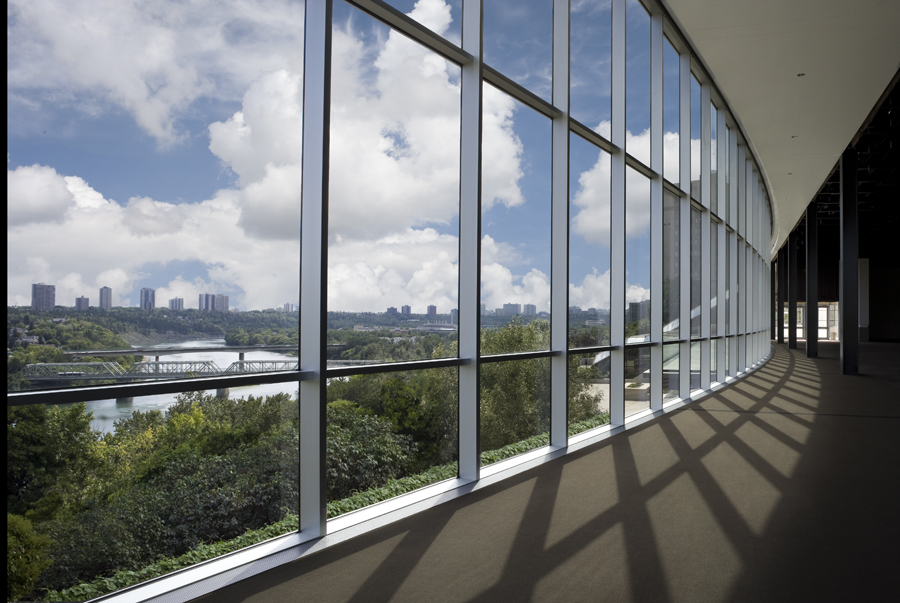
Features
Architectural design
Contracting
Reflecting on Opportunities
Major architectural firms weigh-in on future trends in using glass
October 16, 2009 By TREENA HEIN
In the future, Canadian architects will be using more glass than ever
in their building designs. Architects are keenly aware that like others
around the world, Canadians have a strong and growing appreciation for
natural light inside buildings and for the beauty glass offers on the
outside.

|
|
| Current building trends indicate that the technical aspects of glass will be more influential in glass selection. PCL Centennial Learning Centre, Edmonton. Photo courtesy of Cohos-Evamy. Photo by Tom Arban Photography.
|
In the future, Canadian architects will be using more glass than ever in their building designs. Architects are keenly aware that like others around the world, Canadians have a strong and growing appreciation for natural light inside buildings and for the beauty glass offers on the outside. At the same time, however, architects must also address the public’s desire for highly energy-efficient buildings that are economically feasible.
It is no accident that glass is evolving to allow architects to address all these concerns.
“Glass is one of those amazing materials that has changed from a practical, durable and transparent building envelope component into a highly technical material,” says Keith Robinson, a specification writer and building envelope specialist with Cohos-Evamy in Edmonton. “We’re finding that the technical role of glass has a large impact on aspects of buildings aside from the traditional aesthetic placement,” he says.
“Everything from structural glass enclosures, cooling reductions and control of glare contribute to the decision to use glass. Current trends seem to indicate that the technical aspects of glass will be more and more influential in glass selection.”
 |
|
| As specialty glass products become more affordable they will dramatically change the appearance and design of buildings. Pharma Medica Research building in Scarborough, Ont. Photo courtesy Stanford Downey Architects. Photographer Philip Castelton. |
|
 |
|
| Combined with emerging technologies glass is playing an even greater role in helping the energy performance of the buildings. Hall D – Shaw Conference Centre, Edmonton Photo courtesy of Cohos-Evamy. Photo by Ray Steinke Photography. |
More glass please
Ron Burdock, an architect with WHW Architects in Halifax, Nova Scotia, believes more glass will be used in the future for the simple reason that people aren’t willing to sacrifice quality of life for environmental benefit – they want both, and they expect new technologies to provide both. “When the energy crisis of the 1970s hit, people said ‘We’re going to have to cut windows,’ but now we’re not willing to settle for that,” Burdock observes. “We want that connection to the outside. As technology evolves, the conflict that exists between buildings being open and spacious versus energy efficient is coming to an end. We can address both.”
Others observe that the increasing demand for natural light is not just about enjoying an open atmosphere when inside. “It’s imperative that the users of the buildings have natural light and a view to ensure they are comfortable and thus productive,” says Drew Hauser, an architect with Stanford Downey Architects in Toronto.
While Burdock acknowledges that there still are some technological barriers to achieving high levels of building energy efficiency using glass, “They’re going down,” he says. Highly insulating glass products needed in climates such as ours are being developed.”
New technologies
Some of the insulated products that will be used more in the future are glass spacers and triple-glazing. “We can maintain relatively large glass coverage by using thermally improved framing systems and glass spacers, and providing triple-glazed glass units in critical heat-loss areas,” says Robinson. “We also use triple-glazed assemblies with different glass types (differing thicknesses and laminated lites) incorporated to control exterior noise sources from highways or airports.”
Robinson adds that “We are also looking to combine glass with emerging technologies, “such as phase change heat storage, photovoltaic arrays or liquid exchange heat storage systems to improve the energy performance of the building.”
Some other emerging technologies are still too costly to be used on a widespread basis. These include, says Burdock, the use of coatings that allow windows to be used as solar panels. “We’ll see this within the next few years,” he says. “This has the potential to reduce the amount of energy needed from the grid, and reduce solar energy entering the building while still allowing natural light in.” He also predicts that self-cleaning glass, which provides cleaning through a chemical reaction with rainwater, and glass with liquid crystals, where the darkness of the glass can be controlled with switch, will become much more common than they are now. In terms of what is available now that will lead trends from an energy performance perspective, Hauser points to diffusion glass, as well as fire-rated and glass products with a high R-Value. “As these products become more affordable, they will dramatically change the appearance, design and most significantly, the retrofitting of buildings,” he says.
Hauser is presently using diffusion glass in several projects. “The diffusion glass creates a fantastic quality of light that has no glare and the appearance at all times of day makes for a very attractive building envelope,” he notes. “In the evening, the spaces where we have used this glazing cast a very warm glow.” In designing the Joggins Fossil Cliff Interpretative Centre on the Bay of Fundy, diffusive glass was key, says Burdock. “We have ordinary glass and Solera at both ends of the building which provides fabulous natural light, insulation and diffusion.
This is also used in the building’s multipurpose community room and that, along with the view of the bay, is the reason people absolutely love that room.” “The fire-rated glass has come a long way from the yellow filmy appearance of the past,” observes Hauser. “It will take some time to make this a more affordable product that we will see in smaller projects that have a tighter budget, but when it happens, it will substantially change many spaces that were forced to have opaque separations and allow for greater transparency.”
He adds “We are also investigating fire-glazing for several different projects including science buildings and heritage projects. In a heritage project, it affords a visual connection that is less intrusive than a solid wall; however, it maintains safety and security.”
Howard Rideout of Howard Rideout Architect in Toronto believes spandrel glass will become increasing popular. Spandrels are being used to mask construction materials on the outside and add aesthetic value inside. “Geometric patterning using spandrels, both coloured and screened, will become more popular as a means of creating textured elevations,” Rideout says. “These patterned walls of glass are designed to lessen the solar gain characteristics of the building elevations and thus act more as insulated wall surfaces than traditional glazed surfaces. Light and view are maintained but the elevations become rich, multilayered and have depth and complexity not seen in previous architectural expression.”
Energy and design
As these new solutions are developing, the use of glass and other building materials is becoming restrictive in order to meet energy efficiency standards. The Royal Architectural Institute of Canada (RAIC), for example, has adopted ‘The 2030 Challenge’
(www.architecture2030.org ). It calls on all design professionals “to become actively engaged in reducing fossil fuel use in building construction and operation by a minimum 50 per cent today, 60 per cent in 2010, 70 per cent by 2015, 80 per cent by 2020, and 90 per cent in 2025 to arrive at carbon neutral by 2030.”
Although “LEED (Leadership in Energy and Environmental Design) currently has one of the lowest energy performance expectations of all of the environmental advocacy groups,” says Robinson, “it is still viewed by many as excessive or not easily achievable.” He adds, however, that whether architects as a whole think they are excessive or not, “Future trends in municipal, provincial and federal standards indicate an acceptance of the LEED recommendations…the requirements will become more common, and more stringent over time.”
In terms of his own firm, Robinson says “We use LEED recommendations in our building designs because they are recognized as a step towards energy savings, regardless of whether or not a building is being certified. We cannot see doing something that is right for the environment on the one hand and ignoring the requirements on the other, just because ‘the piece of paper’ is not required.”
This has had one surprisingly negative effect on some of their retail projects, however. The low-E glass used to improve cooling efficiencies is more reflective, which tends to cause worry among clients that potential shoppers can’t see into the store as well, and thus aren’t as enticed to enter. “Sometimes you can do the right thing and still end up wrong – which goes back to the whole technical decision-making criteria,” says Robinson. “You cannot just select glass based on best performance. It has to be tempered with an informed understanding of the aesthetic changes that go along with the technical properties.”
Low-tech meets high-tech
While new glass technologies continue to offer options for energy efficiency, architects are also returning to some good old-fashioned ‘low-tech’ solutions. “Building orientation and using overhangs to prevent heat and light from entering into the building are things that seem to have fallen out of fashion, but we’re rediscovering again,” says Burdock. Hauser notes, “Most recently in our practice, we’ve been using more glass products in conjunction with shading devices to create passive detailing that is energy-efficient and easy-to-maintain.”
These shading devices include shutters. Robinson is using them because even though glass has significantly improved with respect to cooling loads, “We are increasingly being challenged by the requirement to appropriately insulate,” he says. “Combined with insulation and translucent materials, we see shutters as a future solution to improving the heating performance of buildings. The light quality can be maintained and allow greater glass coverage.”
Treena Hein is an award winning journalist based in Ontario.
Print this page
Leave a Reply